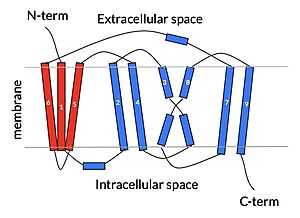Sandbox Reserved 1794
From Proteopedia
(Difference between revisions)
| Line 10: | Line 10: | ||
[[Image:NTCP topography.jpeg|300px|left|thumb|cartoon depiction of NTCP topology]] | [[Image:NTCP topography.jpeg|300px|left|thumb|cartoon depiction of NTCP topology]] | ||
Sodium Taurocholate Co-Transporting Polypeptide, or NTCP, is one continuous polypeptide chain consisting of a total of 9 transmembrane α helices (TM1-9). There are two distinct domains within the quaternary structure of NTCP: a <scene name='95/952722/Ntcp_core_domain-_blue/3'>core domain</scene> (blue) and a <scene name='95/952722/Ntcp_panel_domain-_red/2'>panel domain</scene> (red), both being a part of the same polypeptide chain. The core domain includes 6 transmembrane α helices (TM2-4 and TM7-9) and demonstrates two-fold pseudosymmetry while the panel domain consists of 3 transmembrane α helices (TM1 and TM5-6) and does not display symmetry. Within the core domain, there is a unique crossover between TM-3 and TM-8 that is known as the <scene name='95/952722/Ntcp_x_motif/5'>X motif</scene>. This motif is important because this is where the transporter's substrate binding site is located. | Sodium Taurocholate Co-Transporting Polypeptide, or NTCP, is one continuous polypeptide chain consisting of a total of 9 transmembrane α helices (TM1-9). There are two distinct domains within the quaternary structure of NTCP: a <scene name='95/952722/Ntcp_core_domain-_blue/3'>core domain</scene> (blue) and a <scene name='95/952722/Ntcp_panel_domain-_red/2'>panel domain</scene> (red), both being a part of the same polypeptide chain. The core domain includes 6 transmembrane α helices (TM2-4 and TM7-9) and demonstrates two-fold pseudosymmetry while the panel domain consists of 3 transmembrane α helices (TM1 and TM5-6) and does not display symmetry. Within the core domain, there is a unique crossover between TM-3 and TM-8 that is known as the <scene name='95/952722/Ntcp_x_motif/5'>X motif</scene>. This motif is important because this is where the transporter's substrate binding site is located. | ||
| + | |||
| + | === Active Sites === | ||
| + | NTCP, among others in the SLC10 family, have <scene name='95/952721/Sodium_binding/2'>two sodium binding sites</scene>. Many polar and negatively charged residues are characteristic of these active sites. The high level of conservation among sodium binding placement and interacting residues suggests sodium binding is coupled to bile salt transport. Additional mutations in the X-motif near sodium binding sites have shown that bile salt transport function is lost also suggesting that sodium allows bile salt binding. | ||
| + | <Ref name = "Goutam"> Goutam, K., Ielasi, F.S., Pardon, E. et al. Structural basis of sodium-dependent bile salt uptake into the liver. Nature 606, 1015–1020 (2022). [https://doi.org/10.1038/s41586-022-04723-z DOI: 10.1038/s41586-022-04723-z]. </Ref> It is understood that these sodium binding sites facilitate changes from open-pore to closed pore states of NTCP that allow for the binding or release of bile salts. Closed-pore state is favored in the absence of sodium ions, while open-pore state is favored in the presence of sodium ions. This also allows for sodium concentrations to regulate uptake of taurocholates. When intracellular sodium levels are higher, open-pore state is favored allowing for the diffusion of taurocholates. However, when extracellular sodium levels are high, closed-state is favored preventing diffusion of taurocholates. <ref name="Goutam"/> | ||
| + | |||
| + | The <scene name='95/952721/Hydrophobic_channel/8'>amphipathic pore</scene> is also characteristic of NTCP. The pore surface remains {{Template:ColorKey_Hydrophobic}}, while lining of the open pore state is largely {{Template:ColorKey_Polar}}. This pattern is believed to follow similar amphipathic patterns within taurocholate and other NTCP substrates, such as steroids and statins. <ref name="Goutam"/> Thus the channel provides specificity while preventing leakage of other substrates. When observing the relevant <scene name='95/952721/Bile_salts_res/3'>bile salt binding residues</scene> it is shown that some residues form Van der waals interactions while others will form dipole-dipole or ionic interactions with bile salt substrates. The core domain appears to contribute most of the polar domains, while the panel domain contributes more hydrophobic residues. | ||
=== Conformational Change === | === Conformational Change === | ||
Revision as of 01:12, 29 March 2023
| This Sandbox is Reserved from February 27 through August 31, 2023 for use in the course CH462 Biochemistry II taught by R. Jeremy Johnson at the Butler University, Indianapolis, USA. This reservation includes Sandbox Reserved 1765 through Sandbox Reserved 1795. |
To get started:
More help: Help:Editing |
Sodium Taurocholate Co-Transporting Polypeptide
| |||||||||||
References
- ↑ Stieger B. The role of the sodium-taurocholate cotransporting polypeptide (NTCP) and of the bile salt export pump (BSEP) in physiology and pathophysiology of bile formation. Handb Exp Pharmacol. 2011;(201):205-59. doi: 10.1007/978-3-642-14541-4_5. PMID: 21103971. DOI: DOI: 10.1007/978-3-642-14541-4_5.
- ↑ 2.0 2.1 2.2 Goutam, K., Ielasi, F.S., Pardon, E. et al. Structural basis of sodium-dependent bile salt uptake into the liver. Nature 606, 1015–1020 (2022). DOI: 10.1038/s41586-022-04723-z.

